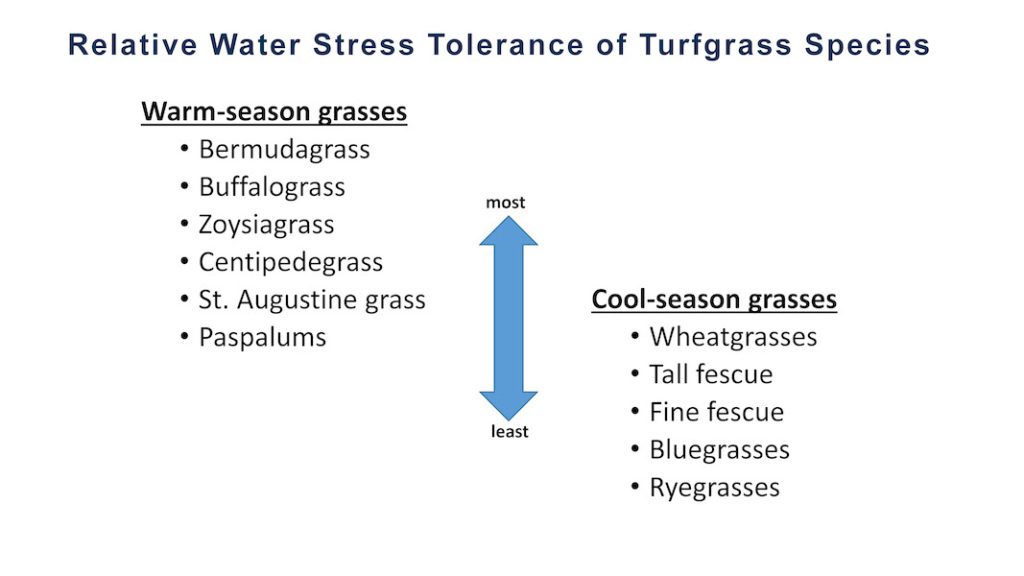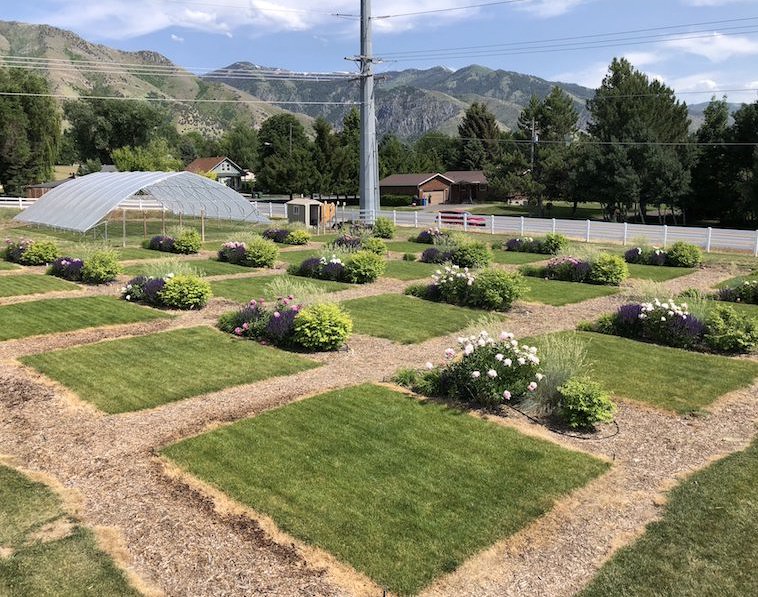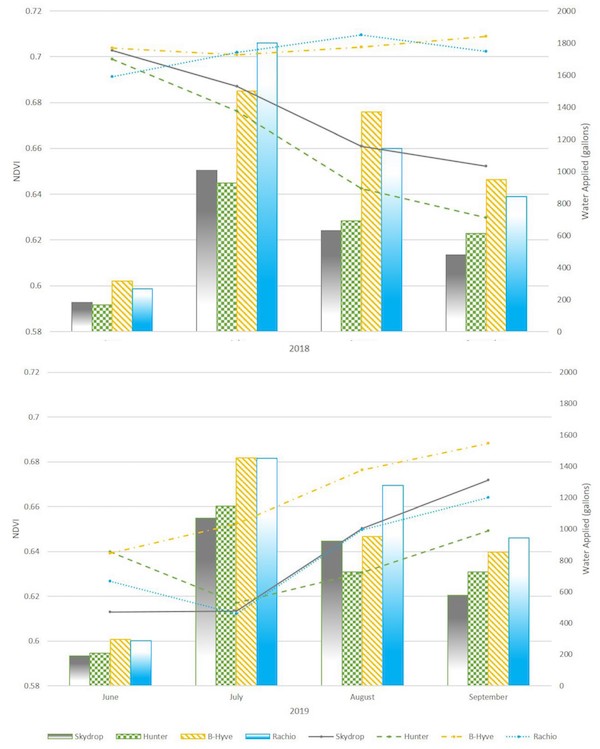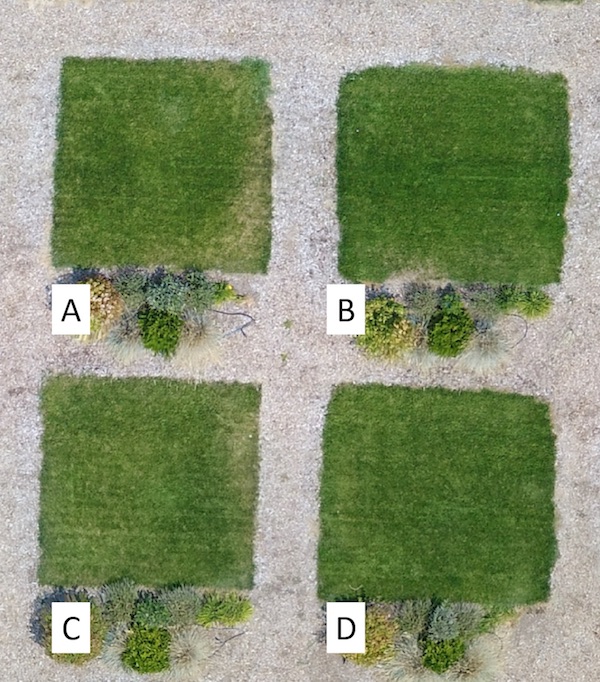By Shane R. Evans, Kelly Kopp, Paul G. Johnson, Neil C. Hansen, Ph.D., and Bryan G. Hopkins, Ph.D., CPSS
Lawn grass acreage is steadily increasing as urban populations grow. These areas include home lawns, community parks, athletic fields and golf courses. In the United States, there are more than 41 million acres of lawn grass, with a large percentage being irrigated (Evans, 2020). To put this into perspective, this is equivalent to ~31 million football fields that would cover an area equal in size to the state of Wisconsin. Additionally, as populations increase, there is also an increase in water demand, resulting in dwindling water supplies (Evans, 2020).
With ~50% of total homeowner water use attributed to lawn irrigation, landscapes containing large areas of lawn grass have a large overall demand for water in some regions. While some question the value of irrigating lawn grasses in urban landscapes, the plants provide many positive ecosystem services, including saving energy for cooling, reducing heat island effects, cleaning air, fostering healthy oxygen and carbon cycles, and providing important mental health benefits to residents. Grass is especially beneficial with regard to carbon sequestration, minimizing soil erosion and leaching of chemicals to groundwater and, of course, recreation and aesthetics. The following are several factors that should be considered for optimizing water application to lawn areas while enhancing the ecosystem services they provide.
Species and variety selection
Some grasses survive drought better than others (see Figure 1). For example, Kentucky bluegrass will typically recover well after drought causes it to enter dormancy. Bermudagrass is also a very drought-tolerant grass.
However, there is a large difference between the minimum amount of water required for grass to tolerate drought and the water required to keep the grass healthy, growing, and actively recovering from stress.
Cool-season grasses have a C3 photosynthetic system that results in poor heat tolerance and relatively high water demand. In contrast, warm-season grasses have a C4 photosynthetic system that results in relatively high tolerance of higher air temperatures and more efficient water use. General species and variety recommendations emphasize those that have exhibited high quality in the National Turfgrass Evaluation Program (NTEP) or other evaluation programs and that are also well adapted for other important traits. In general, varieties that root relatively deeply tend to perform better in terms of water efficiency. It is recommended to choose species and varieties that not only meet athletic field needs, but also root deeply and are water conserving.

Nutrient management
There is a strong interaction between plant nutrition and water relations in plants. In general, a fertile soil with ample nutrition (not deficient or excessive) will enable good grass growth, which in turn allows adequate root growth to explore the soil for stored moisture. Soil and tissue testing are valuable – although imperfect – tools for evaluating nutrient requirements and efforts utilizing complicated, and unproven, fertilizer programs are unnecessary. At a minimum, soil nutrient test concentrations should be at sufficient levels for phosphorus and potassium, as well as most of the secondary macronutrients and micronutrients. Nutrition can be further customized by monitoring nutrient concentrations in plant tissues.
Although these nutrients are important, the most important, especially with regard to water, is nitrogen. Either deficient or excessive nitrogen can result in poor water use efficiency in grasses. Nitrogen deficiency results in poor color and poor overall plant health. Alternatively, excessive nitrogen results in short-term color improvement, but the long-term result is drastically reduced rooting depth and density, which increases water use and frequency of irrigation.
Stress management
Too much stress isn’t good, but some stress can make lawn grasses stronger. Intentionally inducing slight desiccation of grasses in the spring (before the extreme heat of summer) signals a physiological response for roots to grow more deeply. The grass should be stressed to the point of it turning slightly grey and retaining footprints and then fully irrigated immediately afterward.
Deeper root systems result in more efficient water use, whereas shorter root systems make grass more susceptible to heat and other stresses, resulting in the need to irrigate more frequently. This may also decrease plant water use efficiency as more water is lost below the root zone due to leaching (along with mobile nutrients).
Appropriate cultural practices are also vital for healthy grass roots. This is especially true with regard to mowing height and frequency. Along with general impacts on plant health, these can also impact rooting depth/density and, thus, water use efficiency. Contrary to popular opinion, studies have shown that height of cut does not impact athlete speed. Short heights of cut can, however, increase ball roll speed (stimp) for soccer and other similar sports, and is an important factor. Reasonably short mowing heights can also increase crown density, which improves sheer strength and footing. However, the shorter the height of cut, the shorter the root system, especially for species with upright growth habits, such as Kentucky bluegrass.
Most grass species perform best at mowing heights of approximately 2 inches; although, in general, they may reasonably tolerate mowing heights of approximately 1 inch with careful management. There are seemingly successful exceptions. For example, many sports fields with Kentucky bluegrass are mowed as short as ¾ inch, but there are opportunity costs – including the requirement for more water and more frequent mowing. Bermudagrass and other species with prostrate growth habits perform well at even lower mowing heights, with relatively less impact on water relations.
Irrigation management
In general, irrigation is best applied deeply and infrequently, and more than a week may pass in between irrigations during the cooler parts of the growing season. However, “infrequent” irrigation may be applied every other day to low-mowed grass during the heat of summer due to relatively shallow root systems.
Rooting depth decreases as summer heat increases and, therefore, must be examined periodically so that enough irrigation water is added to reach the bottom of the root zone. Frequent, light irrigations do not wet the soil deeply and may result in shallow rooting. In contrast, over-irrigation may force water beyond the root zone, which is wasteful of water, as well as nitrogen and other mobile nutrients. This is especially true in sand-based soils that are prone to leaching losses.
Efficient irrigation also requires a properly designed, installed, and maintained irrigation system without leaks and with high distribution uniformity (DU). Poor uniformity results from systems with leaks that are not maintained or properly designed/installed. Now, no system is perfectly uniform, and it is common with athletic and other high-quality surfaces to eliminate dry spots by watering to ensure the health of the driest area. However, this results in overwatering of other areas. Although perfect uniformity is not achievable, relatively high DU will result in maximum water use efficiency. Measuring and correcting problems that decrease DU should be a regular activity for irrigation managers (Irrigation Association, 2007).
Scheduling the frequency of irrigation is equally important, and there are multiple technologies available to help manage irrigation scheduling. In recent years, evapotranspiration (ET)-based smart irrigation controllers have been shown to reduce water consumption by up to 62 percent as compared to manually programmed time-based controllers (McCready et al., 2009). In most cases, these smart controllers use soil moisture sensors and/or ET calculators to effectively manage irrigation frequency. Soil moisture sensors can provide real-time data and may be used in conjunction with smart irrigation controllers, which can be effective when used properly. Calculating and replacing water lost by ET can also be an effective means of determining water application for smart controllers.
Irrigation controllers
We conducted research on replicated plots to determine the effects of WiFi-enabled smart irrigation controllers on lawn grass health/quality and water consumption in Logan, Utah (see Figure 2). Three controllers used – including the Orbit B-Hyve WiFi sprinkler system (Bountiful, Utah), the Rachio smart sprinkler (Generation 2, Denver, Colo.), and the Skydrop Halo smart sprinkler system (American Fork, Utah). The controllers were programmed to schedule irrigation based on weather data received through a wireless internet connection. The control for the experiment was a Hunter XC-400 (San Marcos, Calif.) irrigation controller. The base programming for this controller was chosen according to Utah State University (USU) Extension recommendations and based on historic (previous 30-year) climate data and a recommended irrigation depth per application of 0.5 inches. Irrigation occurred every 3, 3, 4 or 6 days in June, July, August and September, respectively. The Kentucky bluegrass was grown using recommended cultural management practices.

There were differences in water consumption and grass health across controllers. Comparing total water application for the four controllers, there were two distinct groups. The Rachio and B-Hyve controllers applied 8,500 and 8,200 gallons of water over the course of the study. The Skydrop and the manually programmed (USU guidelines) Hunter controllers applied 33 to 37 percent less water than the others (see Figure 3).
A variety of plant health measurements were taken (Evans, 2020) including normalized differential vegetation index (NDVI) (Figure 3). In 2018, initial measurements of NDVI for each controller began relatively high (0.70 of a possible 1.0). As the season progressed, NDVI values for Skydrop and Hunter controllers decreased each month, while Rachio and B-Hyve controllers maintained relatively high readings. The NDVI trends and associated plant health decreased along with water application with the Hunter and Skydrop controllers applying less water each month as compared to Rachio and B-Hyve controllers. The differences in water application may explain changes in NDVI readings between the controllers as reduced water application also resulted in decreased grass health. In 2019, the Skydrop and Hunter controllers continued to apply less water, but a different trend emerged for NDVI. This may in part be attributed to much higher amounts of rainfall recorded in late August and September of 2019. It is important to note, however, that during both years of the study, NDVI never dropped below 0.61 or rose above 0.72. In terms of aesthetic quality, this difference might be noticed by some and not by others.

Applying less water resulted in lower NDVI values. But does the drop in NDVI affect playability and aesthetic value? Does the potential reduction in water use of 33 to 37 percent justify these lower NDVI values? Such questions must be answered by each landscape manager, because a variety of factors can influence land-use decisions. The human factor has a large impact on water management and the idea of what constitutes an ideal landscape. This will differ depending on whether you ask the field manager, those who use the field, or those who simply observe the lawn. In Figure 4, plots A and B received higher water than C and D. Less water resulted in less healthy grass, but the results may very well be acceptable if slightly less healthy grass is an acceptable trade off with water conservation.

In many cases, however, water conservation is highly desired, and even mandatory, and the irrigation controllers evaluated in this study can help achieve a balance between aesthetics and water consumption. We do not present these results as an endorsement of any particular product. All can be effective water-conservation tools, and they each may be programmed to be more water conservative.
The results of this study show that, over the course of two growing seasons, thousands of gallons of water may be saved with a minimal drop in plant quality, as measured by NDVI. Additionally, when comparing water application of the smart irrigation controllers to the manually programmed controller, similar water savings were achievable when using University Extension recommended irrigation schedules.
Shane R. Evans is lawn water conservation educator in the Department of Horticulture Science at the University of Minnesota.
Kelly Kopp is professor, Extension water conservation and turfgrass specialist in the Plants, Soils, and Climate Department at Utah State University.
Paul G. Johnson is department head, professor, Turfgrass Management/Genetics in the Plants, Soils, and Climate Department at Utah State University.
Neil C. Hansen, Ph.D., is department head and professor of Soil Science in the Plant and Wildlife Sciences Department at Brigham Young University.
Bryan G. Hopkins, Ph.D., CPSS, is a professor of Soil Science in the Plant and Wildlife Sciences Department at Brigham Young University.
This article is based on a presentation of the same title given by Dr. Bryan G. Hopkins at the Sports Turf Managers Association Conference, West Palm Beach, Fla., on Jan. 14, 2020. (https://intelliquestmedia.com/store/events/sports-turf-2020/202001112)
Resources and citations
Evans, S. 2020. “Effects of Wi-Fi-Enabled Irrigation Controllers on Water Use and Plant Health in Residential Landscapes in the Intermountain West.” Masters thesis. Utah State University.
Irrigation Association. 2007. Landscape Irrigation Auditor. The Irrigation Association. Falls Church, VA.
McCready, M.S., M.D. Dukes, and G.L. Miller. 2009. “Water conservation potential of smart irrigation controllers on St. Augustinegrass.” Agricultural Water Management 96:1623-1632.

